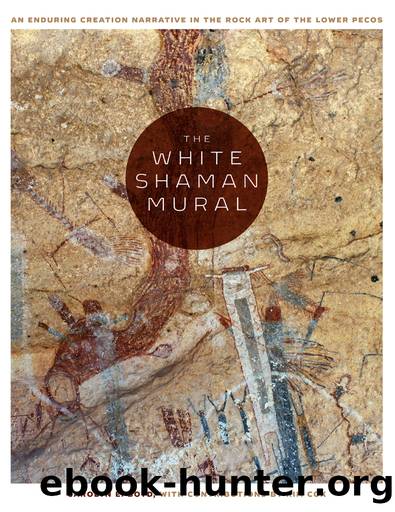The White Shaman Mural by Carolyn Boyd

Author:Carolyn Boyd [Boyd, Carolyn E.]
Language: eng
Format: epub
Publisher: University of Texas Press
Published: 2016-11-15T00:00:00+00:00
Figure 6.6. The sinuous black and white lines run parallel to each other only between A001 and A006, thereby linking the first Ancestor (A001) to the antlered anthropomorph (A006) and marking the transition from the rainy season to the dry season.
Figure 6.7. The sinuous line transitions from white to black (E029) at E007.
Figure 6.8. Sustenance rope. Redrawn from Codex Magliabechiano 30.
Table 6.2.
Motif Analysis II: Sinuous white and black line (E029)
In the Mixtec Bodley Codex two adults are linked by an umbilical cord representing not only a relationship of descent, but also alliance between two related groups.27 The umbilical cord metaphorically represents the road along which goodsâlike blood, and therefore sustenanceâflowed between them. The causeway traveled by the procession of fire priests as they carried the new fire from the Hill of the Star to the Temple of the sun at Templo Mayor likewise can be viewed as a metaphorical umbilicus (Monaghan 1994:95). The Nahuatl word ohtlatoca translates as âto follow a roadâ and âto go along in life.â It refers to the path of the sun and the moon along the ecliptic, but also the road traveled by traders bearing their goods (Read 1998:250 fn49). Among the Maya, sakbehs, or âwhite roads,â reference the color and construction of ancient Mayan roads, as well as metaphorically a cosmic umbilicus and the Milky Way (Schele and Mathews 1999:114) (Monaghan 1994:95). They also represent the road of life and the passage of time (Keller 2011:156).
. . . the conflation of roads and time entails not only a linear path from there to here, but also multiple, interwoven cycles of time that form the fabric of life. The road of life is likened to the roads of the sun, moon, and stars that run in great circles around our everyday world forming transits in the sky and tunnels through the underworld. By walking along their roads, the Maya performed time. They displayed the passage of time, and the transition of temporal cycles as spatially rooted entities. [Keller 2011:156]
As with the Huichol, the earth was perceived to be surrounded by either two snakes or one snake with two heads. It divided the heavens from the underworld, and the sun, traveling its daily course across the sky, was consumed by this giant serpent when it set each day in the western horizon. The horizon, with its undulations, represented this reptilian beast. Serpentine motions and snake imagery, however, also evoke an association with the undulations of the ecliptic path (Milbrath 2013:128 fn60). Sinuous sky ropes, threads, and white cotton cords link heaven and earth, mortal and divine, past and present, throughout Mesoamerica (Milbrath 1999:74). As discussed in the previous chapter, they represent the eclipticâa celestial floral pathway (Flower Road) traveled by the sun, the gods, and the Ancestors.
Pages 33 and 34 of the pre-Columbian Codex Borgia relate the story of the birth of the sun. On Borgia 33, a white cord descends from the top of a celestial temple (figure 6.9). This cord has been interpreted in different but complementary ways.
Download
This site does not store any files on its server. We only index and link to content provided by other sites. Please contact the content providers to delete copyright contents if any and email us, we'll remove relevant links or contents immediately.
The Japanese by Christopher Harding(1085)
Watercolor With Me in the Forest by Dana Fox(753)
A Theory of Narrative Drawing by Simon Grennan(742)
The Story of the Scrolls by The Story of the Scrolls; the M(725)
Glittering Images: A Journey Through Art From Egypt to Star Wars by Camille Paglia(717)
Boris Johnson by Tom Bower(620)
This Is Modern Art by Kevin Coval(597)
The Art and Science of Drawing by Brent Eviston(589)
Frida Kahlo by Frida Kahlo & Hayden Herrera(585)
AP Art History by John B. Nici(575)
Banksy by Will Ellsworth-Jones(569)
War Paint by Woodhead Lindy(551)
Van Gogh by Gregory White Smith(547)
Draw More Furries by Jared Hodges(544)
Scenes From a Revolution by Mark Harris(543)
About Looking by John Berger(543)
Ecstasy by Eisner.;(535)
100 Greatest Country Artists by Hal Leonard Corp(523)
Young Rembrandt: A Biography by Onno Blom(514)
